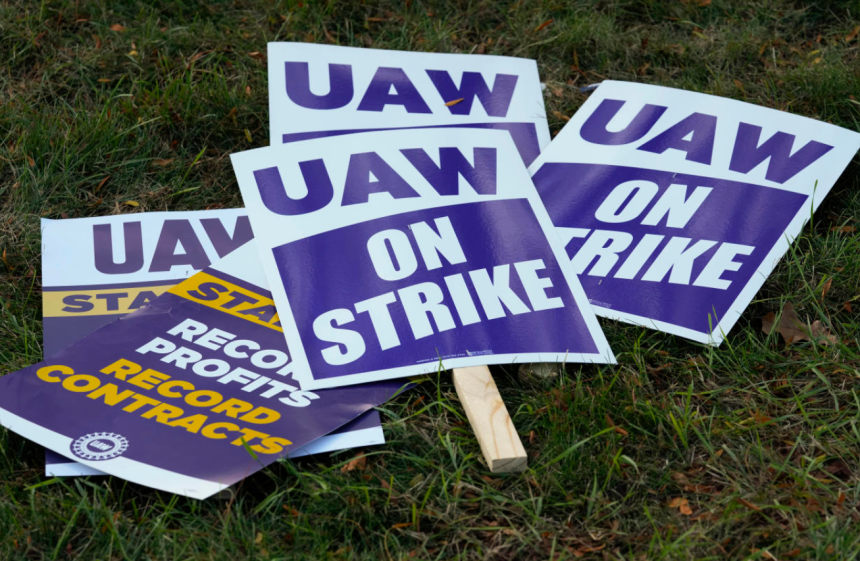Faced with another $200 million in losses due to a protracted strike this week, General Motors CEO Mary Barra finished her weekend by visiting the United Auto Workers’ Detroit headquarters in the hopes of negotiating a new deal.
At the meeting, which began late Sunday, they were able to strike an agreement with UAW President Shawn Fain and other bargainers early Monday, which should end a controversial six-week work stoppage, according to three sources briefed on the subject.
The tentative agreement, which arrived on Fain’s 55th birthday, concluded a frantic few days of negotiations with 146,000 UAW members at GM, Ford, and Jeep-maker Stellantis. Ford agreed to a new deal last week, and Stellantis followed suit on Saturday, putting pressure on GM to accept exactly the same conditions.
According to the people, who asked not to be identified because they weren’t authorized to speak publicly about the deal, all agreed to contracts that would last four years and eight months, raise general wages for top assembly plant workers by 25%, and add cost of living adjustments that would bring their pay increases to more than 30% by the time the contracts expire on April 30, 2028. Upon approval, workers would get an immediate 11% wage increase.
Fain’s birthday should be a joyful one as a result of the arrangement. Contracts with the Detroit Three, according to most industry observers, represent successes for the UAW, which had wanted large gains to compensate for sacrifices made to assist the businesses survive the Great Recession of late 2007 to 2009.
However, throughout the negotiations, the firms stated that they were hesitant to accede to the union’s conditions, believing that they would compel them to hike car costs higher than competitors with nonunion plants in the United States, such as Toyota and Tesla.
The incentive was obvious for GM, which was losing millions of dollars each week the strike lasted: reach an agreement so that it could open an SUV factory in Spring Hill, Tennessee, on time Monday morning, and bring a highly profitable truck-based SUV facility in Arlington, Tennessee, back up as soon as possible.
It was unclear if the Tennessee facility opened on schedule, but around 18,000 striking workers at GM assembly facilities and parts warehouses throughout the country remained on picket lines Monday morning, awaiting formal confirmation from union authorities that the strike would end.
Mike Huerta, president of UAW Local 602 in Lansing, Michigan, was cautious to applaud the contract until additional information was available, stating that “the devil’s in the details.”
“Our negotiators did their job. “They’ll present us with something, and we’ll have to tell them whether it’s good enough or not,” Huerta said.
Huerta stated, with workers crowded around a fire behind him, that it’s been a difficult few nights on the picket lines, with decreasing temperatures and rain, but that spirits have stayed high.
“We were prepared to continue if necessary,” Huerta stated. “And if we do turn it down, we’ll be ready to go back again.”
Shammira Marshall, a forklift driver at GM’s parts facility in Van Buren Township, Michigan, west of Detroit, said the tentative agreement will make the holidays a little sweeter this year.
“Christmas, Thanksgiving, and the New Year — that’ll help,” she added of her upcoming rise.
Marshall was on his second strike against GM, having crossed picket lines in 2019. As word of a bargain spread, she and other UAW members began to dismantle a tent used by strikers.
“This time it wasn’t bad, because I knew what to expect,” she told me.
GM was the latest business to negotiate an agreement, which occurred after almost 4,000 union workers unexpectedly walked out of GM’s largest North American plant in Spring Hill, Tennessee, on Saturday night.
President Joe Biden was asked about the accord as he boarded Air Force One to return to the White House on Monday. He gave a thumbs up and stated, “I think it’s great.”
Also on Monday, 8,200 Stellantis workers in Canada were briefly on strike before striking an agreement that included basic hourly salary hikes of roughly 20% for production workers. General Motors and Ford employees in Canada have already ratified a three-year deal with the corporation.
Spring Hill, where workers went on strike Saturday, manufactures engines for cars manufactured at nine sites as far away as Mexico, including Silverado and Sierra trucks. It’s a significant money generator for GM that might have exacerbated the company’s financial woes after workers went on strike last week in Arlington, Texas, where full-size SUVs like the Tahoe and Suburban are manufactured. The electric Cadillac Lyriq, GMC Acadia, and Cadillac crossover SUVs are also manufactured by Spring Hill.
The presidents of the Ford union locals voted unanimously on Sunday in Detroit to support that preliminary deal after UAW President Shawn Fain revealed its specifics, according to the union.
In a later livestream, Fain and Chuck Browning, the UAW vice president, said the deal represents a “historical inflection point” for resurrecting union power in an America where “we were being left behind by an economy that only works for the billionaire class.”
“UAW members at Ford will receive more in straight general wage increases over the next 4 1/2 years than we have over the last 22 years combined,” Browning said in a statement.
Fain described the settlement as “a turning point in the class war that has been raging in this country for the past 40 years.”
The accords bring back cost-of-living increases that the UAW agreed to forgo during the Great Recession in 2009.
Workers at Stellantis receive cost-of-living raises of 33%, with top assembly plant workers earning more than $42 per hour. Top-tier employees now earn roughly $31 per hour.
Starting salaries for new Stellantis employees will increase by 67%, including cost-of-living adjustments, to more than $30 per hour. Temporary workers will be paid more than 165% more, while workers at parts centers would be paid 76% more immediately if the deal is ratified.
According to the union, new workers will be able to reach the top of the assembly wage range in three years, similar to the Ford accord. Similarly, the union was granted the power to strike in response to factory closures.
After its contracts with the corporations ended on September 15, the UAW initiated targeted strikes against all three automakers. At its peak, around 46,000 UAW workers were on strike, representing almost one-third of the union’s 146,000 members across all three firms.















